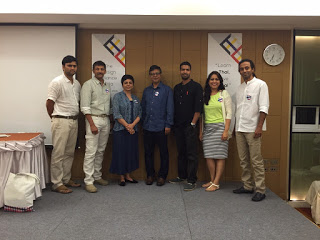INFLUENCE OF LOCAL CULTURE
Mayuri:
It was heartening as well as inspiring to see a lot of influence of local culture and traditional forms in modern day design. The Arabic typography projects shared by Designer
Tarek Attresi, drew a lot of inspiration from local calligraphy & markings, yet is global & contemporary. Traditional objects from local culture creatively inspire designer Pham Huyen Kieu’s, Haki Craft objects.
However, the corporate work done is very much global in approach & appearance. The bank branding done by Color Party, Thailand or the
products designed by NDD Design, Taiwan are truly global.
Ashish:
Yes, Design inspiration can stem from traditions & customs. However, in Asia, it also draws from local needs & economic conditions. That is why many times to make economic sense, design needs to have a universal appeal. Design & Designers in Asia tend to play a dual role. You see this prominently in Colour Party, Thailand or NDD Design, Taiwan work. However, William Harald Wong, Malaysia museum design draws sensibly from local folklore & crafts. The same can be said about the Book project shared by Subrata Bhowmick.
Shrish:
Evolution is still continuing around the same factors like traditional habits, religion. The original essence of the design is maintained to a certain extent making it very local and specific to particular region or country.
Prasad:
Design needs to solve problems. If a designer does not understand the culture of the people for whom he or she is designing, then it is sure to end up creating more problems. Understanding local culture, language, lifestyle of people and its nuances is critical. A designer fails if he is Insensitive to this and does not make a genuine attempt to actually understand culture and the people in context of the problem.
Shrish:
Though the problem would remain the same it is simply astonishing to see various solutions we would have in different parts of the country or the continent. These solutions are derived form the local culture, behavior and beliefs of people. The long-term solutions that would require a global and holistic approach often get neglected resulting in local design and design approach.
Partho:
It is still a challenge for Asian designers to align their solution to the cultural ethos and principals. Most of the culture led design, incorporates certain traditional motif and patterns in their solutions very successfully.
Anand:
Profession of Design has always functioned as a reaction to the needs
& aspiration of people, markets and technology. Aspiration of people is still largely driven by what happens in the Western world.
Developed countries have always been on the forefront of technology and design. Design in Asia seems to follow “the west”.
Leading brands today develop their markets based on the 'economy' of the geographies and design simply caters to that. So in such cases, I see very little or no influence of culture or region on Design in Asia at least as far as Industrial Design goes. Not sure if this is a point of concern or not, but it surely is reflection of The Flat World.
Ashish:
Let me take a few examples. The Rattan chair designed by late Irvan Noe’man, BD+A which received Good Design Mark, Japan and the Bhoomi pot series designed by Elephant, India are good examples of Industrial Design drawing influence from local crafts, customs. Freeman Lau’s chairs and much of the package design work by KL&K, Hong Kong are classic contemporary interpretations of regional crafts and customs.
Anand:
In 50s, Honda developed a motorcycle ('step through' segment) for SE region catering to the local needs of traditional clothing (read culture), muddy &
bad roads and affordability. This was a huge success. Today after many years the segment is still very popular, albeit people who do not dress traditional, have smaller families and road conditions are far better than in the past.









